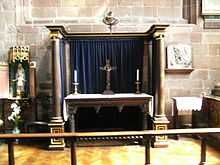St Peter's Collegiate Church
| St Peter's Collegiate Church, Wolverhampton | |
|---|---|
|
St Peter's Collegiate Church | |
| Denomination | Church of England |
| Previous denomination | Roman Catholic |
| Churchmanship | High Church |
| Website | www.wulfruna.org.uk/index/PetersChurch |
| History | |
| Dedication | Saint Peter |
| Administration | |
| Parish | Central Wolverhampton |
| Diocese | Lichfield |
| Province | Canterbury |
| Clergy | |
| Rector | The Rev'd Preb David Wright |
| Priest(s) | The Rev'd Eddie Brookes |
| Curate(s) | The Rev'd Jo Williams |
| Laity | |
| Organist/Director of music | Peter Morris |
| Organist(s) | Matt Rose, Toby Barnard, Ralf Ayling-Miller, Dr. David Rendell |
| Churchwarden(s) | Sue Bowden and Deborah Castle |
| Verger | Maureen Bolton |
St Peter's Collegiate Church is located on the highest and the oldest developed site in central Wolverhampton, England.[1] For many centuries it was a chapel royal, and from 1480 a royal peculiar, independent of the Diocese of Lichfield and even the Province of Canterbury. The collegiate church was central to the development of the town of Wolverhampton, much of which belonged to its dean. Until the 18th century, it was the only church in Wolverhampton and the control of the college extended far into the surrounding area, with dependent chapels in several towns and villages of southern Staffordshire.
Fully integrated into the diocesan structure since 1848, today St Peter's is part of the Anglican Parish of Central Wolverhampton. The Grade I listed building, much of which is Perpendicular in style, dating from the 15th century, is of significant architectural and historical interest. Although it is not a cathedral, it has a strong choral foundation in keeping with English Cathedral tradition. The Father Willis organ is of particular note: a campaign to raise £270,000 for its restoration was launched in 2008.[2]
History
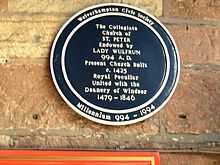
St Peter's is an Anglo-Saxon foundation. The history of St Peter's was dominated for centuries by its collegiate status, from the 12th century constituted as a dean and prebendaries, and by its royal connections, which were crystallised in the form of the Royal Peculiar in 1480. Although a source of pride and prosperity to both town and church, this institutional framework, hard-won and doggedly defended, made the church subject to the whims of the monarch or governing elite and unresponsive to the needs of its people. Characterised by absenteeism and corruption through most of its history, the college was involved in constant political and legal strife, and it was dissolved and restored a total of three times, before a fourth and final dissolution in 1846 cleared the way for St Peter's to become an active urban parish church and a focus of civic pride.
994–1066: Origins and endowments
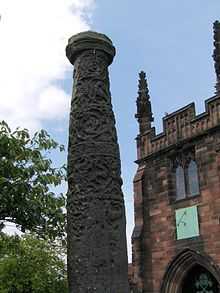
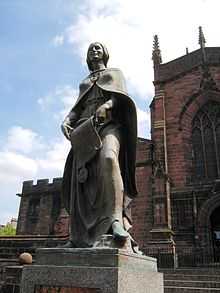
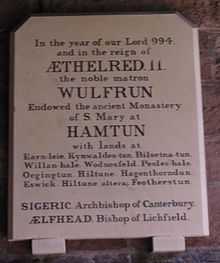
There is some doubt abut the origins of the College of Wolverhampton. A charter was discovered around 1560, by which Sigeric, Archbishop of Canterbury, confirms Lady Wulfrun's endowment of a Minster at Hampton in the year 994-5.[3] The authenticity of the charter is in some doubt,[4] as it was allegedly discovered in the ruins of a wall at Lichfield and has since been lost. An alternative explanation is that the 7th century King Wulfhere of Mercia was involved in the founding of the town, the church, or both. The only real evidence for this is his name, preserved in the not far-distant settlement of Wolverley, which seems superficially similar. However, older forms of the town's name run against this hypothesis. Shortly after the Norman Conquest we find the College referred to as the church of Wolvrenehamptonia. This certainly suggests that the eponym was Wulfrun rather than Wulfhere, although this does not guarantee that she was the founder: the settlement could date back to some earlier time. The name almost certainly means the High Town or Chief Settlement of Wulfrun.
Wulfrun apparently granted the College lands in or around Upper Arley, Eswich (probably Ashwood, Staffordshire, which was Haswic in Domesday), Bilston, Willenhall, Pelsall, Ogley Hay, Hatherton (near Cannock), Kinvaston (near Penkridge) Featherstone, and two villages called Hilton—one near Ogley and the other by Featherstone. There were also lands at Wolverhampton itself, probably those which Wulfrun herself had received from Ethelred II by a charter of 985.[5] The Arley lands probably came from a grant which King Edgar the Peaceful had made to Wulfgeat, a relative of Wulfrun, in 963.[6] In fact, before, the discovery of Wulfrun's charter, Edgar was generally accepted as the founder of the College.[7]
The church was originally dedicated to St Mary and this was still the dedication at the Domesday survey of 1086: it was switched to St Peter in the mid-12th century. It seems likely that the College always consisted of secular clergy —priests who did not belong to a religious order, rather than monks. A writ attributed to King Edward the Confessor (1042–1066) refers to the College as "my priests at Hampton". Although the document is known to be a forgery, probably dating from a century later, the secular character of the College seems to have been accepted unchallenged, despite the implication in the foundation charter that it was a monastery. All of the Domesday entries relating to the church of Wolverhampton refer to clergy, canons or priests, never monks. There is no evidence that a monastery ever existed at Wolverhampton. If there was, it seems odd that Wulfrun would replace it with a secular chapter.
A college was not originally an educational institution but rather a body of people with a shared purpose, in this case a community of priests charged with pastoral care over a wide and wild area. Colleges of priests were not unusual in the Middle Ages, particularly in the Anglo-Saxon period, although they persisted long after. At a time of scattered population, poor communications and frequent lawlessness, it made sense to organise local ministry in teams that could offer mutual support and collective management of resources. From their central base, they could tour the surrounding hamlets, celebrating the Eucharist, preaching and teaching. In most cases, such settlements would not initially have a church building at all, but at most a cross to mark the place of worship. The later parish system organised under diocesan bishops only became truly viable as a landscape of peaceful villages emerged in the later Middle Ages.
1066–1200: The struggle for autonomy
It is not clear when the College began to have a close connection with the Crown, although this was to become a defining characteristic, which shaped much of its history. The forged letter of Edward the Confessor is meant to point to just such a close relationship, but we know it dates from a century later, after the church had Wolverhampton had passed through a series of difficulties which it probably wanted to resolve permanently.
At the Norman Conquest, Wolverhampton's church was given by William the Conqueror to his own personal chaplain, Samson. Domesday shows that the canons of the College now held some of the property donated by Wulfrun as tenants of Samson. The estates at Kinvaston, Hatherton, Featherstone and nearby Hilton were rented out by Samson to other priests, Edwin and Alric. The canons also held land at Lutley, Worcestershire, and claimed woodland at Sedgeley, neither of which was in Wulfrun's grant. At Arley, some of their land had been seized forcibly by one Osbern, while Bilston now belonged to the Crown. At Wolverhampton, the canons' land was cultivated by 14 slaves, alongside 36 other peasants. The church also had slaves at Upper Arley. The expansion of the royal forests, hunting grounds for the king and his retainers, had hit the region hard and Wolverhampton was almost surrounded, with the Forest of Kinver up to its southern edge, and the Forest of Brewood and Cannock Chase to the north. This took substantial areas out of agricultural production, making them almost valueless to the College: there were five hides at Ashwood now subsumed into the Forest of Kinver, for example. Despite the direct royal patronage and the close attention of the royal chaplain, the Conquest had brought difficult times for the canons.
Samson was elected Bishop of Worcester in 1096. Presumably he had been in only minor orders, as he had to be ordained first deacon and then priest on a single day, before being consecrated as bishop the following day. He became notorious, despite his vow of clerical celibacy, as the father of at least three children, two of whom later became bishops. During the reign of Henry I, he donated the church at Wolverhampton to his cathedral priory at Worcester, although its lands and privileges were protected.[3]
However, The Anarchy, the confused civil strife of King Stephen's reign, brought great challenges. First the church was seized by Roger, Bishop of Salisbury, who was Lord Chancellor, the kingdom's senior bureaucrat. Roger had vowed loyalty to the Empress Matilda, Henry I's daughter and chosen heir, but immediately broke his word on Henry's death. His support was crucial in allowing Stephen to consolidate his rule after his coup d'état in 1135, and he used his influence to seize as much property as he was able, constructing vast castles and building a powerful ruling clique that included his nephews, Nigel, Bishop of Ely and Alexander, Bishop of Lincoln. Stephen felt threatened by his over-mighty Chancellor and moved against him in 1139, seizing all his estates, including the church at Wolverhampton and its lands. Stephen promised initially to restore the Wolverhampton church to its rightful owners, but then he handed it over to the diocese of Coventry and Lichfield, whose bishop, Roger de Clinton, was an important military leader in Stephen's cause and had just returned from a mission to explain Stephen's case to the Holy See. The canons were outraged at this betrayal of trust, which left them at the mercy of a powerful magnate in their own vicinity, and appealed to Pope Eugenius III. This campaign is the likely context for the creation of much of the facsimile or forged material that provided the church with a foundation narrative. It is also notable that the dedication was changed to St Peter around this time, and this too would be a flattering move in negotiations with Rome. Sometimes documents attest a dedication to St Peter and St Paul - a still more fulsome manoeuvre. Whatever dedication is given, the church's seals generally picture both saints.[8]
The church's lobbying seems to have been very successful. Clinton died in 1148 and Wolverhampton was restored to the monks of Worcester before 1152. Stephen had by this time been forced to agree that he would be succeeded by Matilda's son, Henry Plantagenet, at that time already Duke of Normandy and Duke of Aquitaine. Even before he succeeded to the throne, Henry issued a charter in which he described the church at Wolverhampton as "my chapel", restored all its privileges from the time of Henry I, and recognised it as free from secular taxation. As soon as he came to the throne in 1154 as Henry II, he issued another charter recognising the right of the canons to hold a manorial court.[3] Neither of these charters explicitly stated Wolverhampton was not subject to the jurisdiction of the Bishop of Lichfield. However, Peter of Blois, probably appointed to head the College by Henry II shortly before his death in 1189, said that the church was subject only to the Archbishop of Canterbury and the King. Clearly, in Henry II's reign, the College already had an independence not enjoyed by most other institutions of the same kind.
1200–1224: Dissolution and restoration
By the time Peter of Blois was appointed, the College was organised as a community of prebendaries, headed by a dean. This structure was probably imposed during the period of control by Lichfield, as this was the system established at Lichfield cathedral itself around 1140.[9] Each prebendary drew his income from a prebend, a collection of lands and rights attached to tenure of a choir stall, and which determined where he would have pastoral and liturgical duties.
Peter was a poet and a diplomat of great experience. He had been tutor to William II of Sicily, one of the most cultivated rulers of his time, and he was himself a man of refinement and vision. He considered the prebendaries hopelessly corrupt, desperate to keep their positions, wealth and power within a tight grouping of families, held together by intermarriage. After more than a decade of struggle to reform the College, he resigned his post and put forward a revolutionary plan from outside.
Peter persuaded Archbishop Hubert Walter that it was necessary to dissolve the College completely and to replace it with an Abbey of Cistercian monks, an ascetic French order dedicated to a radical and literal interpretation of the Benedictine Rule. The plan was approved by both King John and Pope Innocent III, a reforming pontiff. John gave his formal consent for the new abbey in January 1203, although it appears that he had already appointed one Nicholas to the deanery. John handed over the prebends and deanery of Wolverhampton to the archbishop in order to support the abbey. Over the next two years, John also granted it the manors of Wolverhampton and Tettenhall, gave it the wood of Kingsley in the Forest of Kinver, and granted it a charter of liberties. The archbishop put the plan to the General Chapter of the Cistercian Order and brought some Cistercian monks to Wolverhampton in readiness.
Just as all these preparations were about to bear fruit, Hubert Walter died. Without him, the entire scheme collapsed. Within a month, John had changed his mind completely and appointed a replacement dean of Wolverhampton: Henry, son of Geoffrey Fitz Peter, 1st Earl of Essex,[3] his Chief Justiciar. Even before he was chosen, the first phase of a new church building had been started. The most logical starting point, given a clean slate, was the tower crossing: it remains to this day, the sole relic of the 13th-century building, and a reminder of the near-dissolution of the church. Henry Fitz Geoffrey, well-connected to all the centres of power in the kingdom, held the post of dean for nearly two decades, blocking reform or abolition.
1224-1300: Disputes and prosperity
Giles of Erdington, who became Dean of St Peter's around 1224, was a talented lawyer and was already set on a career that would make him one of Henry III's most eminent judges,[3] a Justice of the Common Bench. Erdington was to remain dean for 45 years and he placed all his skill at the service of the college. On appointment, he seized the opportunity afforded by the appointment of a new and inexperienced bishop, Alexander Stavensby, to make a formal deal with the Diocese of Lichfield. The dean's right to appoint and discipline his prebends was recognised. The bishop was to intervene only if there was evidence the dean was not carrying out these functions. For his part, the dean recognised the bishop's right to be received with honour at St Peter's and to administer the sacraments there. In 1260 Erdington repelled an attempt by Bishop Roger de Meyland to hold a visitation, in contravention of the agreement with the diocese, by appealing directly to the king and getting a royal prohibition.
Erdington was equally vigorous in promoting the economic interests of the college. Throughout, Erdington was concerned that the church benefit from the town's booming trade, which was based mainly on wool, promoting general growth rather than exacting every penny. To make clear the college's territorial sway, he had the boundaries walked ceremonially. In 1258 he secured from Henry III the lucrative right to hold a weekly market and an annual fair, both of which took place thereafter at the foot of the church steps. In 1263 he won the support of the town's burgesses by granting them the right to succeed to their burgages without fee. The town is sometimes described as a "deanery borough". A borough had no fixed legal status before the 19th century municipal reforms, but was generally understood to be a town with a community of free townspeople and civic institutions. The college was now recognised as the collective lord of the manor, and through the dean recognised the effective autonomy of the civic community, explicitly placing the burgesses on an equal footing with the county town of Stafford
The next dean, Theodosius de Camilla, appointed in 1269, was just as vigorous as Erdington in defending the college, but his tenure began to demonstrate some of the disadvantages of royal appointment. He was prepared to defend the college even against the Archbishop of Canterbury. The Second Council of Lyons in 1274 denounced a number of abuses of which the prebendaries were plainly guilty, including non-residence and pluralism. In fact Camilla himself was non-resident, as he was mostly involved in royal business, and it is not even certain that he ever visited Wolverhampton: he operated mainly through bailiffs, who carried out his instructions and transactions. At least three of the canons were Camilla's relatives, and they seldom appeared in the town either. Archbishop John Peckham was determined to bring the royal chapels to book. On 27 July 1280 the archbishop, against an explicit prohibition of Edward I, appeared at the doors of St Peter's, which were promptly shut in his face. He summoned the prebendaries to meet him on 31 July but they, together with the canons of all seven royal chapels, ignored him and were excommunicated. Proceedings were launched against the seven chapels in the ecclesiastical courts. This forced the king to act, and he swiftly brought the archbishop to heel, pressuring him to agree that he would accept a royal decision on the chapels within the Diocese of Coventry and Lichfield, and also in London. Bishop Meyland too was induced to agree never to visit six of the chapels, including Wolverhampton.
The archbishop's feud with Camilla continued, however. In 1282 Camilla was excommunicated and deprived of two other churches that he held. Peckham even claimed that Wolverhampton was not rightly his, as Canterbury had the patronage. However, he obtained monetary compensation for his two lost churches in 1286. He also pursued the local dispute with the diocese until 1292, when Bishop Meyland finally recognised that all seven royal chapels within its bounds were subject only to the Pope. Camilla developed the lands of the college by encouraging the tenants to enclose wastes, although he also encouraged his bailiffs to over-exploit woodlands. When he died in 1295, he was still Dean of Wolverhampton, despite all opposition.
Erdington and Camilla brought St Peter's to its medieval peak of prosperity and influence, although its spiritual standards were already notorious. The economic well-being of the church was greatly improved by their unwillingness to pay tax. Camilla was deriving 50 marks a year from the deanery by the 1290s, but declared only 20 marks for tax purposes. The total taxable value of the church was declared in 1293 as only £54 13s. 4d. This included six prebends, which are named for the first time at this point: Featherstone, Willenhall, Wobaston, Hilton, Monmore, Kinvaston. In addition there was the chantry of St. Mary in Hatherton, which was shortly to become a seventh prebend. Deans and canons alike increasingly gained an income from their estates not through their own management, but by farming, which in this period meant leasing the right to receive rents and dues to someone else, who then made a profit by exploiting them to the fullest possible extent.
1300-1479: Neglect and revival
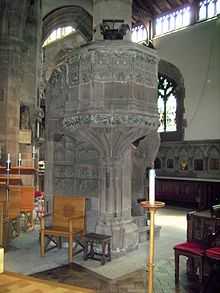

While the 13th century deans had been shrewd business men on behalf of the church, the 14th century deans stripped its assets, and in some cases resorted to plain embezzlement.[3] One of the most important problems was that they began to enclose waste for themselves and then to sell it off, alienating it from the church's estates. John of Everdon (1295–1303), Philip of Everdon (1303–23) and Hugh Ellis (1328–39) all pursued personal enrichment in this way. Hugh also gave away much of the stock of the deanery and left the buildings dilapidated. By 1368, things had reached such a pass that Edward III himself ordered a visitation of Wolverhampton to investigate loss of property and privileges, fraud, loss of books and ornaments, neglect of services and misconduct by the canons. In fact, Wolverhampton's deans had remained zealous in maintaining the college's rights and privileges, getting successive kings to confirm its charters, but most of the other accusations were true.
The king's enquiry had no effect. Dean Richard Postell (1373–94) embezzled an income set aside for six priests to celebrate the liturgy—something the dean and prebendaries themselves no longer did. Lawrence Allerthorpe (1394–1406) and Thomas Stanley (1406–10) continued to neglect the deanery and enquiries followed both their deaths. In addition, the townspeople complained about the neglect of spiritual duties under both Postell and Allerthorpe. Enquiries generally found that the dean and all the prebendaries were absentees. The prebendaries actually employed vicars to perform their duties for them. This was the age of the Black Death, which brought about a spiritual crisis that the church was ill-equipped to confront. Despite this neglect, there were still plenty of pious people prepared to make large donations and bequests to the church. There were two chantry chapels in the collegiate church, both well-endowed. A special body, the "wardens of the light", was founded in 1385 to tend a light in honour of St Peter. Priests were maintained at Pelsall, Willenhall and Bilston from special, earmarked endowments left by parishioners.
A remarkable product of this piety was St Mary's Hospital—not a centre for medical treatment but an almshouse. It was established through the efforts of William Waterfall, a generous layman, and Clement Leveson, a chaplain at St. Peter's, during the years 1392-95.[10] First they obtained a royal licence for the hospital, then Waterfall endowed it with three acres of land and obtained the lord of the manor's permission. The land was only 400 metres south east of St. Peter's but it fell outside the manor of Wolverhampton, in the manor of Stowheath, which was held by Hugh, Lord Burnell, a powerful marcher lord.[11] Finally they obtained Dean Allerthorpe's permission, as the land fell within the jurisdiction of the college. Patronage went to William and Joan Waterfall and their heirs, but was to pass to the Leveson family if they lapsed. The regulations bound the chaplain to say mass and vespers daily for the residents, and prayers were to be offered for the souls of Clement Leveson, William and Joan Waterfall, Lord Burnell, and Lawrence Allerthorpe. The first recorded chaplain was John Pepard, inducted in 1402. Presumably this is why the institution came to be known as Pepers Chapell and later Pyper's Chapel: Piper's Row is still a well-known street name, now the site of the City's bus station.
Amid this clerical neglect and lay piety, some of the college's ancient privileges were again challenged. In 1401 Allerthorpe had just been appointed Lord High Treasurer by Henry IV, newly established on the throne after overthrowing Richard II of England. It was at this point that Archbishop Thomas Arundel, a key supporter of the king, sent delegates to carry out a visitation of St. Peter's. Allerthorpe objected but had to back down, as there was little doubt whose support was most important to Henry.
However, the decline was stemmed by two vigorous deans, whose work in the town roughly spans the Wars of the Roses. John Barningham was appointed in 1437 and showed a genuine interest in the church, the town and its people. It was he who began the rebuilding of the church in approximately its present form. When he died in 1457, he left money not only for the rebuilding but also for the poor of the town. William Dudley, his successor, managed much of the rebuilding. He was also Dean of Windsor, the first Dean of Wolverhampton to hold both posts. He resigned in 1476 to become Bishop of Durham and was later a key supporter of Richard III. By simply spending some of their time on its affairs, after a century of neglect, these men were able partially to rebuild the college's relationship with the town.
After Dudley moved to Durham, Lionel Woodville, the Queen's brother was dean for a few years, but he resigned when he became Chancellor of the University of Oxford. In 1479, Richard Beauchamp, already Bishop of Salisbury and Dean of Windsor, was appointed.
1479–1603: Royal Peculiar and Reformation

The year after Beauchamp's appointment, Edward IV resolved that, thereafter, the same person should be Dean of Windsor and Dean of Wolverhampton. It is from this point that Wolverhampton is generally considered a Royal Peculiar or Peculier. In fact, it had claimed and vindicated its status as a royal chapel, independent of the diocesan authorities, for many centuries already. From 1480, however, it was formally placed on a footing with St. George's Chapel, Windsor Castle, the monarch's own household chapel. It was never subsumed into Windsor. For about half a century, about half of the prebendaries were also canons of Windsor, but this practice petered out in the 16th century.[3] The link between Wolverhampton and Windsor persisted purely through the dual role of the deans and Wolverhampton kept its own seal–a key indicator of institutional independence.
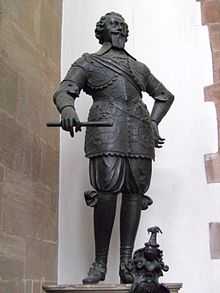
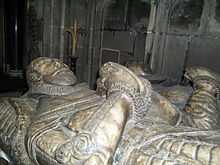
As the deans and most of the canons continued to be absentees, their lands and rights were increasingly farmed out. From 1516, it was James Leveson, one of the immensely rich and powerful Merchants of the Staple who increasingly took over responsibility for exploiting their estates. The rent agreed for the deanery holdings was £38, and Leveson managed to keep it fixed for 25 years, despite steady inflation. He also gradually extended his investments into the prebendary holdings. The Leveson family inherited and extended his interests after he died. (The name Leveson is pronounced /ˈluːsən/ loosen and is a patronymic from Louis or Lewis)
The Reformation brought dissolution for the second time in the college's history. It was threatened under the first Chantry Act in 1545 but survived because Henry VIII died before it could be implemented. Edward VI's Protestant guardians brought in a second act in 1547. The Dean argued that Wolverhampton should be exempt, as Windsor was specifically excluded from the terms of the act. Nevertheless, the college was dissolved and replaced by a vicar and curates, on £20 a year. This was not a great hardship for the dean and canons, as they continued to receive pensions at the same level as their former income from their benefices. Moreover, the canons had farmed out most of their holdings on perpetual leases, at fixed and very low rents, to the Leveson and Brooke families—allegedly in the hope of recovering them later and protecting the college's investments, but probably to make a quick gain before dissolution. The sale was authorised by the chapter of Windsor, which was not lawful, as the two colleges had separate seals and finances. The prebendary and the deanery estates themselves were confiscated by the Crown, then granted to John Dudley, 1st Duke of Northumberland, the leading figure of Edward's later, and more radically Protestant, government.
However, Queen Mary's Counter-Reformation soon restored the old regime. As Northumberland was attainted, his property was forfeit, so it was relatively easy to restore the college's property. This was presented by Mary's letters patent as a favour to St. George's College, Windsor. However, Mary's gracious act left the years 1547–53 in legal limbo, with the status of any transactions carried out by the canons during those years uncertain. St. Peter's was the only royal peculiar in the region to be restored: all the others proved intractable, as the property had been sold or given to landowners in good standing, many of them pious Catholics. The little hospital of St. Mary was not so fortunate. The provision to say prayers for the dead would have guaranteed its dissolution as a chantry and it is never heard of again, apparently absorbed into the Leveson estates.
Despite a decision to follow a broadly Protestant path, Elizabeth did not pursue the matter further, and confirmed the restoration of the college by royal charter in 1564. This meant a restoration of the old abuses. The deans and most of the canons stayed away, failing to attend even the quarterly chapter meetings and paying scant wages to deacons, and in some cases unordained readers, to perform their functions at St. Peter's. The running of Wolverhampton's church devolved upon the sacrist, who was paid a separate income, amounting to the reasonable sum of £26 by the mid-17th century, and given a seat on the chapter. In the satellite chapels at Bilston, Pelsall and Willenhall, curates were paid £4 or £5 a year to maintain an active ministry. A Puritan survey carried out in 1604 found that all three curates then in office were drunkards and non-preachers.
1603–1660: Religious strife and civil war

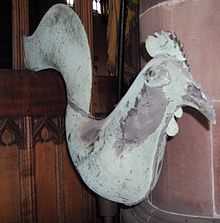
For Puritans, who wanted to renew and broaden the Reformation, the running of St. Peter's was one of the most notorious scandals in the Church of England. Locally, the initiative was taken by Richard Lee, who was appointed to the prebend of Willenhall in 1622 by a sympathetic dean, and who denounced what he saw as the sins of his time. The temper of the town was mainly Puritan and anti-royalist, so Lee seems to have met a warm response. However, Matthew Wren, appointed Dean in 1628 was a supporter of William Laud, leader of the High Church party that came into the ascendancy with the accession of Charles I. He particularly objected to the fact that Lee had taken up residence in Wolverhampton and preached regularly.[3] Wren became a bishop in 1634 and was succeeded by Christopher Wren, his brother and the father of the famous architect. This Wren immediately realised that Lee was beyond his control and took panic measures to deal with him. Surrendering a privilege that had survived since 1280, he called in Archbishop Laud himself to conduct a visitation. Lee was suspended and a purge of Puritan parishioners was launched. Wren celebrated with an elaborate ceremony to consecrate a new High Altar in the church, with incense and music, all calculated to offend the Puritans.
This short-lived triumph for the Laudians came at a price. When the Long Parliament assembled in 1640, Laud's arrest was one of its first acts. In 1644, during the English Civil war, he was brought to trial for treason and the events at Wolverhampton were high on the list of accusations brought against him. Evidence against him was given by two Wolverhampton men, Leonard Lee, Richard's brother, and William Pinson. Although the trial itself was inconclusive, Laud was attainted and beheaded a few months later.
St. Peter's church itself suffered considerable damage at the hands of Parliamentary soldiers in 1642. Much worse was an attack on the chapter house by royalist soldiers under Colonel Leveson, which resulted in the loss of all its records. A law of 1643 suppressed all deans and chapters and, after the fighting drew to a close in 1646, the college was dissolved, for the third time in its history. Its assets were vested in trustees, and they provided £100 for a minister - none other than the apparently stainless Richard Lee. However, Lee appears to have taken on two other parishes - Melbourne and Rugby - and was in no great hurry to quit either.[12] The post of sacrist was abolished and his £26, together with a further £50, was provided for an assistant minister. This allowed the trustees to raise the incomes of the other ministers to viable levels too. The minister at Shareshill was granted £100 and the minister at Wednesfield £50. However, this all happened in the absence of the Levesons, who had claims on six of the prebends since the reign of Edward VI, but whose property was sequestrated. Once the sequestrations were discharged in 1652, the Levesons reclaimed their lands at the former low, fixed rents, and the trustees' careful financial management fell apart.
The Restoration of Charles II automatically brought the restoration of the college at St. Peter's, as the legislation abolishing it was regarded as invalid. Everything was restored very quickly. However, the loss of the records at the hands of Leveson, whose family coincidentally had important claims on college property, was a serious problem for the restored institution.[3]
1660-1848: Decline and demise of the old order


%2C_Wolverhampton_-_geograph.org.uk_-_373088.jpg)
The college was hampered financially from its restoration. It challenged the Levesons legally but the Court of Chancery dismissed the case in 1667 and awarded Robert Leveson costs.[13] Leveson sold his Wolverhampton estates to the Earl of Bradford, his nephew, in 1705 and the college went to court again to recover its alienated lands. This time the case was dismissed immediately. Not until 1811 did the college finally abandon its attempts to recover its property - more than two and a half centuries after its loss.
All the dependent chapels but Kinvaston were now very poorly funded and unable to attract able or dedicated ministers. They were still expected to contribute to the upkeep of St. Peter's and to the expenses of the sacrist, who doggedly defended his income from burials and other rites. They were now starting to chafe at the bit. Bilston revolted against the dean's attempts to impose a curate twice—in 1730 and 1735—and the congregation elected their own.
The population of Wolverhampton itself and of the towns to the east was growing rapidly as manufacturing took hold. Peniston Booth, a dean who actually spent some of his time at the deanery house in Wolverhampton, was sufficiently in touch with opinion to authorise the building of new chapels of ease at Wednesfield, Willenhall and Bilston. With considerably more persuasion, and after a major public campaign fronted by Lord Grey, he acquiesced in the building of a new chapel of ease in Wolverhampton itself.[14] It was authorised by a private Act of Parliament in 1755, and the fine Neo-Classical St John's Church, Wolverhampton quickly rose on a site enclosed in a square to the south of St. Peter's.
The college, with its deanery and prebends, was increasingly proving a straitjacket for the Anglican Church in Wolverhampton. The increasing population was a challenge in itself, but it also brought social misery and discontent as the crowded housing of the Wolverhampton and the Black Country failed to keep up with demand. Increasing religious diversity was another consequence. There had been Protestant Dissenters since the Civil War, but their numbers were greatly increased by the preaching of Methodism: in 1761 John Wesley himself preached at an inn-yard in what he called "this furious town" of Wolverhampton.[15] Catholic recusancy was strong in the surrounding countryside. Despite the Penal laws, in the 1730s the Giffard family of Brewood succeeded in building a Catholic chapel in the guise of a private house, just to the west of St. Peter's. As Catholic Emancipation approached, this was rapidly expanded into a functioning Roman Catholic church.[16] Already, distress in Ireland was bringing immigration and a large working class, Irish Catholic community, concentrated to the north of St. Peter's in the slums of an area known as "Caribee Island".[17]
In 1811 a special Act was passed to reform St. Peter's church itself. The post of sacrist was replaced by that of perpetual curate. Three readerships were abolished and their income signed over to the curate. A fund was established from proceeds of mining on the deanery land to improve the income of the curate. This did not go far enough. The curate was still heavily dependent on fees from the dependent chapels and friction over this continued to sour relations. However, the curates initially performed their duties very much better than earlier sacrists and things were improved further by the building of a new chapel of ease in the town: St. George's, another Neo-Classical structure, completed in 1830 to a design by James Morgan.
It was in connection with a possible post at St. George's that William Dalton, an Evangelical Anglican clergyman from Ulster first visited Wolverhampton. He returned in 1835, after marrying Sarah Marsh, the widow of a Bilston ironmaster, to take up the living of St. Paul's, yet another chapel of ease on the south-western edge of the town. Dalton began a lifelong campaign to build more churches to serve the growing population. Dalton's agitation had a venomously anti-Catholic edge, attacking both Anglo-Catholicism and Roman Catholicism,[18] but his church-building campaign won wide support. It further undermined the relevance of the dean and the Royal Peculiar.[19] St. Peter's itself and all the new chapels already operated as parish churches in all but name, but were hampered by lack of funds. The deanery was a sinecure that took £600 a year out of the town - largely the product of coal mining on deanery lands.[13]
The radical Whig administration of the 1830s was determined to remedy a wide range of abuses at the local level. The establishment of elected municipal self-government for Wolverhampton and most of England's towns and cities came in 1836. This swept away the last vestiges of ecclesiastical influence in the politics of Wolverhampton and created a much stronger expectation of local accountability. In the same year, the Ecclesiastical Commissioner was established, aimed at rationalising the finances and structures of the Church of England, and charged with recommending further legislation to reform the Church. Henry Lewis Hobart, the Dean of Windsor and Wolverhampton, was generally considered a wealthy nonentity and had failed to win any real support at Court. The perpetual curate, Dr. George Oliver, appointed in 1834, was a quarrelsome man who had alienated all the local clergy, mainly in disputes over burial fees. The Cathedrals Act of 1840 decreed that the deanery should be suppressed on the death of Dean Hobart. The prebends were left vacant in readiness and, on Hobart's death in 1846, the deanery was wound up. In 1847, Dr. Oliver resigned and the post of perpetual curate was suspended, with John Dakeyne appointed sacrist, pending a full reorganisation. In 1848, a specific piece of legislation for St. Peter's, the Wolverhampton Church Act, abolished the ancient college altogether and transferred all its assets to the Ecclesiastical Commissioners. They swiftly oversaw the establishment of a rectory for St. Peter's and confirmed Dakeyne as rector. All the dependent chapels were turned into separate parish churches, each with its own vicar. From the available funds, the Commissioners were able to grant the rector a living of £750 a year, and to improve the incomes of all 13 of the other clergy involved, as well as to contribute to building repairs. St. Peter's and all the newly established parishes became part of the Diocese of Lichfield, subject to the bishop as Ordinary.
Timeline
Architecture
St Peter's Church is built of red sandstone on an elevated site in the centre of the City of Wolverhampton. The oldest part of the building above ground is the crossing under the tower, which probably dates from the beginnings of the Abbey in 1200, followed by the Chapel of Our Lady and St George (Lady Chapel). Much of the Church was rebuilt and extended in the fourteenth century, in the Decorated Style. However, the Church was to be substantially altered in the middle of the fifteenth century at the expense of the town's wool merchants, with the addition of a clerestory to the nave, and reduction in height of the north and south aisles. The upper part of the tower was rebuilt around 1475 to a height of 120 feet, and the Chapel of St Catherine and St Nicholas (Memorial Chapel) was completed at the end of the fifteenth century. The chancel was reconstructed in 1682 following considerable damage caused to the original medieval one during the Civil War, and it was again completely rebuilt in 1867 as part of the extensive restoration of the Church under architect Ewan Christian.[1]
Unique features include the carved stone pulpit with a figure of a lion at the foot of the steps to protect the minister delivering the sermon. The font dates from 1480 with several stone carved figures and the west gallery dates from 1610, paid for by the Merchant Taylors' Company for use by the boys of Wolverhampton Grammar School.
Near the south porch is a 14-foot-high stone column, carved in the ninth century with birds, animals and acanthus. It may have been a column pillaged from Roman Viroconium and brought to Heantune, either as part of a preaching cross or memorial. The carvings have deteriorated, but a cast made in 1877 can be seen in the Victoria and Albert Museum in London.
Bells
The bells of St. Peter's are the second oldest complete ring of 12 in the country and third oldest in the world, all twelve cast in 1911 by Gillett & Johnston of Croydon.
Five bells are known to have existed at St. Peter's in 1553. In 1698 a new 23 cwt. ring of eight was cast by Abraham Rudhall I. In 1740 Henry Bagley III of Chacombe cast a large ‘funeral’ (or hour) bell of some 35 cwt. In 1827 the eight were augmented to ten by Thomas Mears. The ten ringing bells were rehung by Barwells in 1889 and the seventh was recast in 1895 by Mears & Stainbank after cracking during a peal attempt.
The bells, including the hour bell, were recast and two new trebles added to produce a new ring of twelve by Gillett & Johnston. This was their first complete ring of twelve, to be followed by Coventry in 1927, Croydon in 1936 and Halifax in 1952. They were tuned on the 5 tone Simpson Principle in the key of C sharp major. Gillett also provided a new single-tier steel and iron H-frame with new fittings throughout. The clock chime was connected to the 3rd, 4th, 5th and 8th and the clock generally rearranged. They were rung for the first time as 12 for the coronation of King George V after a silence of three years. The front eight were subsequently rehung in 1977 and the tenor in 1985.
In April 2000 maintenance work was carried out. The 9th, 10th and 11th were rehung on new bearings and the pulley on the 10th was renewed. The 12 ductile-iron clappers were replaced by the original, overhauled wrought-iron clappers and other minor works carried out. All work was carried out by Whitechapel Bell Foundry of London.
The bells are rung twice weekly, on Mondays for practice and for the main Sunday service.[21][22]
Music
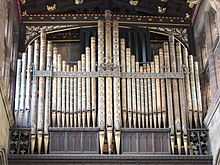
The three-manual Father Willis organ, was built in 1860.[23] A campaign to raise £300,000 towards its restoration was launched in 2008. The restoration work, designed to return the organ to its former glory after the wear and tear of near-daily use, is due to be completed by Principal Pipe Organs of York.
On Saturday 25 September 2010 a concert of Elgar's greatest pieces was held at the church which included the very first football chant, He Banged The Leather for Goal, written by Elgar himself,[24] in respect of Wolves star of the time, Billy Malpass. The concert was a joint venture between the church and Wolverhampton Wanderers to raise funds for the organ appeal and to firm the link that Elgar had between respective organisations. Elgar was a Wolves fan and cycled from Malvern (a good 40 miles approx)) to watch the Wolves with close friend Dora Penny, daughter of then St Peter's Church Rector Revd Penny. St Peter’s director of music Peter Morris said: “We wanted to celebrate the connection between Elgar and the church, so we got in touch with Wolves and it just grew. “We knew about Elgar’s connection with the club because the rector’s daughter Dora Penny used to write about him going to watch them when he came to visit.”[25]
There is a strong choral tradition: more than 70 children and young people are involved in the Music at St Peter's, along with Lay Clerks and choral scholars. There are separate boys' and girls' choirs, each of which generally sings at a Cathedral during the Summer holidays. The Boys' Choir, Lay Clerks and choral scholars sang at Lincoln Cathedral in 2007, York Minster in 2008, Norwich Cathedral in 2009, Rochester Cathedral in 2010, Ely Cathedral in 2011, Wells Cathedral in 2012, Chichester Cathedral in 2013 and Ripon Cathedral in 2014. The girls choir, Lay Clerks and choral scholars sang at Chester Cathedral in 2007, Chichester Cathedral in 2008 and 2010, Carlisle Cathedral in 2009, Canterbury Cathedral in 2011, Truro Cathedral in 2012, Salisbury Cathedral in 2013 and Exeter Cathedral in 2014.
The church is involved with the Choristers Outreach Programme of the Choir Schools Association and Sing Up which takes choristers into Primary Schools in the city to help the singing programmes in schools.
The Director of Music is Peter Morris and the Assistant Director of Music is Matt Rose. The assistant organists are Toby Barnard, Ralf Ayling-Miller (Organ Scholar) and Dr. David Rendell (Organist Emeritus).
List of organists
- This list is incomplete; you can help by expanding it.
|
|
|
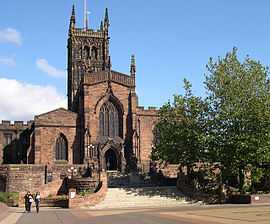
Today
Worship is in the Catholic tradition of the Church of England. Vestments, reservation and the sacrament of reconciliation are all part of its tradition with incense used at festival services. Sunday services usually comprise Holy Communion, Choral Eucharist, and Choral Evensong. Choral Evensong is also sung on Wednesdays at 5.15pm.
St. Peter's is open on weekdays and Saturdays, and before and after services on Sundays. There is a shop within the church and a coffee lounge in the nearby St. Peter's House.
The church has links with St. Peter's Collegiate School, which, although originally founded adjacent to the church in 1847, is now located at Compton Park, along with St Edmund's Catholic Academy and part of the University of Wolverhampton.
Lists of Incumbents
Deans of Wolverhampton
Rectors of St. Peter's Collegiate Church
After the suppression of the deanery, a new sacrist, John Dakeyne, was appointed in 1847, with a view to making him rector on the winding up of the college. This duly occurred in the following year.
|
|
|
See also
References
- ↑ 1.0 1.1 "The Collegiate Church of St Peter in Wolverhampton" (PDF). Parish of Central Wolverhampton. Retrieved 2008-10-12.
- ↑ "Organ Appeal" (PDF). Parish of Central Wolverhampton. 2008. Retrieved 2008-10-12.
- ↑ 3.0 3.1 3.2 3.3 3.4 3.5 3.6 3.7 3.8 Victoria County History - Staffordshire: Vol. 3, no. 44: M W Greenslade, R B Pugh (Editors), G C Baugh, Revd L W Cowie, Revd J C Dickinson, A P Duggan, A K B Evans, R H Evans, Una C Hannam, P Heath, D A Johnston, Professor Hilda Johnstone, Ann J Kettle, J L Kirby, Revd R Mansfield, Professor A Saltman (1970): Victoria County Histry: A History of the County of Stafford: Volume 3, no. 44, Colleges: Wolverhampton, St Peter.
- ↑ The Electronic Sawyer: Online catalogue of Anglo-Saxon charters, S 1380 This gives a summary of comments on the document.
- ↑ The Electronic Sawyer: S 860
- ↑ The Electronic Sawyer: S 720
- ↑ VCH - Staffs, Vol.3.44
- ↑ See for example, the 13th century seal reproduced at "The Collegiate Church of St Peter in Wolverhampton" (PDF). Parish of Central Wolverhampton. Retrieved 2008-10-12.
- ↑ VCH - Staffs, Vol.3.6.s2
- ↑ VCH - Staffs, Vol.3.38: The Hospital of St. Mary, Wolverhampton
- ↑ Entry for Hugh Burnell at the peerage.com
- ↑ The Clergy Database See record 27765, retrieved June 2011.
- ↑ 13.0 13.1 13.2 VCH - Staffs, Vol.3.44.
- ↑ Peter Hickman: St. John's in the Square at Wolverhampton Local History
- ↑ John Wesley's Journals at A Vision of Britain Through Time.
- ↑ Giffard House and St. Peter and St. Paul's Church at Wolverhampton Local History
- ↑ Roman Catholicism in Wolverhampton 1828–1865 at Wolverhampton Local History.
- ↑ Roman Catholicism in Wolverhampton 1828–1865 at Wolverhampton Local History.
- ↑ Peter Hickman: The remarkable story of the Reverend William Dalton at Wolverhampton Local History.
- ↑ "Christian places of worship in Wolverhampton". University of Wolverhampton. Retrieved 2008-10-12.
- ↑ "The Bells". St. Peter's Guild of Change Ringers, Wolverhampton. Retrieved 2010-01-09.
- ↑ "The Collegiate Church of St Peter". Parish of Central Wolverhampton. Retrieved 2008-10-12.
- ↑ "ORGAN OF THE MONTH 47: May 2006". Birmingham Organists' Association. May 2006. Retrieved 2008-10-12.
- ↑ Richard Alleyne (26 September 2010). "Sir Edward Elgar wrote football chant along with his classical music". Daily Telegraph. Retrieved 2010-09-27.
- ↑ http://www.expressandstar.com/news/2010/09/23/choirs-songs-to-honour-wolves-legend-malpass
- ↑ Staffordshire Advertiser - Saturday 23 April 1836
- ↑ Hertford Mercury and Reformer - Saturday 22 January 1842
- ↑ Staffordshire Sentinel and Commercial & General Advertiser - Saturday 28 July 1860
- ↑ Hubbard, W. L., ed. (1908) The American History and Encyclopedia of Music. 4 vols. Toledo [US]: Irving Squire
External links
- The Parish of Central Wolverhampton
- St Peter's Wolverhampton Choir
- St. Peter's Guild of Change Ringers
- Diocesan website
- Google Virtual Tour of St Peters Church, Wolverhampton
| ||||||||||||||||||||||||||||||

